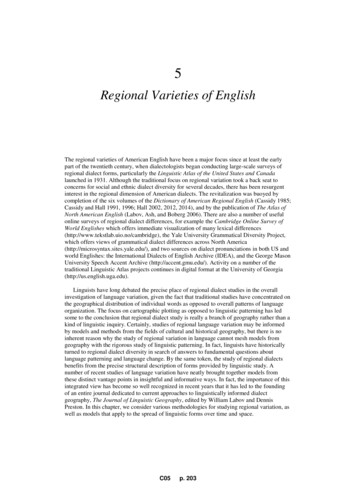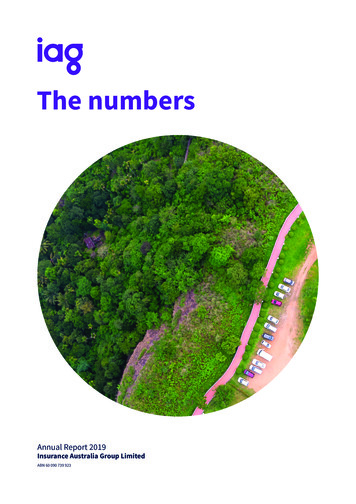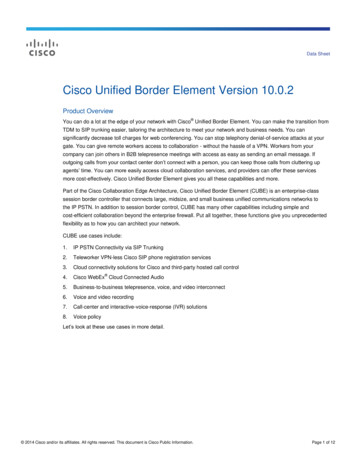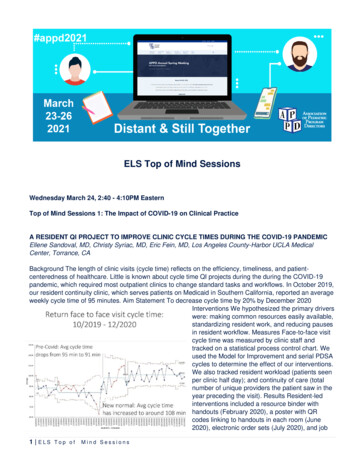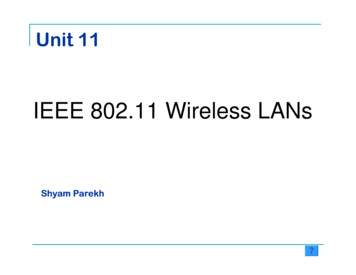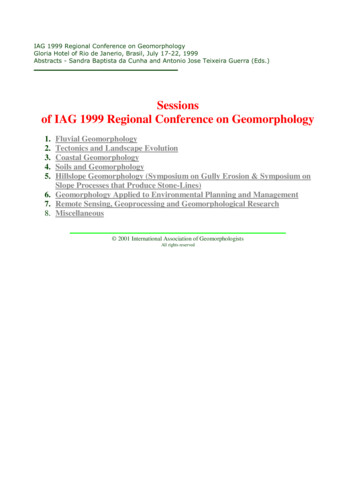
Transcription
IAG 1999 Regional Conference on GeomorphologyGloria Hotel of Rio de Janerio, Brasil, July 17-22, 1999Abstracts - Sandra Baptista da Cunha and Antonio Jose Teixeira Guerra (Eds.)Sessionsof IAG 1999 Regional Conference on Geomorphology1.2.3.4.5.Fluvial GeomorphologyTectonics and Landscape EvolutionCoastal GeomorphologySoils and GeomorphologyHillslope Geomorphology (Symposium on Gully Erosion & Symposium onSlope Processes that Produce Stone-Lines)6. Geomorphology Applied to Environmental Planning and Management7. Remote Sensing, Geoprocessing and Geomorphological Research8. Miscellaneous 2001 International Association of GeomorphologistsAll rights reserved
IAG 1999 Regional Conference on GeomorphologyGloria Hotel of Rio de Janerio, Brasil, July 17-22, 1999Abstracts - Sandra Baptista da Cunha and Antonio Jose Teixeira Guerra (Eds.)Abstractsdelivered at IAG 1999 Regional Conference onGeomorphologySESSION: Fluvial Geomorphology1. FAN SYSTEMS IN SWAMPLANDS OF MATO-GROSSO STATE-BRAZIL2. THE GEOMORPHOLOGY OF THE TAQUARI RIVER IN THE PANTANAL, BRAZIL3. MARGINAL EROSION AND LANDUSE IN THE PEIXOTO RIVER BASIN - PRATA BRAZIL4. GEOMORPHOLOGICAL ANALYSIS OF THE SAO MIGUEL BASIN, JEQUITINHONHAVALLEY, MINAS GERAIS5. RIVER STYLES: A GEOMORPHIC TEMPLATE FOR ANALYSIS OF BIOPHYSICALPROCESSES ALONG RIVER COURSES6. ASSESSMENT OF SEDIMENT DELIVERY RATIO IN LOESS PLATEAU, CHINA7. THE ANTONINA AND PARANAGUÁ BAY'S REGION, BRAZIL: ENVIRONMENTALZONING8. THE JOÃO FERREIRA CREEK, UPPER RIO DOCE BASIN, MINAS GERAIS, BRAZIL: ANEXAMPLE OF COARSE-GRAINED MEANDERING RIVER9. EVOLUTION OF THE RIVERS SECCHIA AND PANARO IN THE PO PLAIN IN THE 19THAND 20TH CENTURIES (MODENA PROVINCE, NORTHERN ITALY)10. BRAZILIAN RIVERS: IMPACTS OF RIVERS ENGINEERING AND THE POTENCIAL FORRESTORATION11. DISSECTION PATTERNS AIDING GEOLOGICAL MAPPING OF THE LOWERSOLIMÕES REGION - AMAZON12. A PRELIMINARY STUDY OF THE CHANNEL NETWORKS STRUCTURE OF A FIRSTORDER DRAINAGE BASIN, WESTERN PARANA STATE, BRAZIL.13. GEOMORPHIC APPROACH TO IDENTIFICATION OF RIVER RECOVERY POTENTIAL:APPLICATION IN BEGA CATCHMENT, SOUTH COAST, NSW, AUSTRALIA14. DAMS, SAND-MINING AND SEDIMENTS - A BUDGETING APPROACH FOR MGENIESTUARY NEAR DURBAN, SOUTH AFRICA15. MORPHOLOGY, DRAINAGE AREA AND FLOW RELATIONS FOR BAHIA'S RIVERS16. RIFFLE-POOL LANDFORMS AND FLOOD HISTORY IN A DESERT GORGE, AUSTRALIA17. STREAM SOLUTE RESPONSE IN THE SMALL POST-GLACIAL CATCHMENT, WESTPOMERANIA, POLAND18. ANALYSIS OF THE USE OF THE SOIL IN DIFFERENTGEOMORPHOLOGICAL/LITHOLOGICAL COMPARTIMENTS
19. THE CONTRIBUTION OF THE FLUVIAL SEDIMENTS IN THE GEOMORPHOLOGICALEVOLUTION OF THE JACAREPAGUÁ LAGOON, RIO DE JANEIRO20. URBAN DRAINAGE NET: MAN ACTION IN THE THIRD ORDER CHANNELS PAQUEQUER RIVER, TERESÓPOLIS - RIO DE JANEIRO21. GEOMORPHOLOGICAL ASPECTS OF THE HYDROGRAPHIC BASIN OF THE RIVERTAPAGEM - RONDONIAIAG 1999 Regional Conference on GeomorphologyGloria Hotel of Rio de Janerio, Brasil, July 17-22, 1999Abstracts - Sandra Baptista da Cunha and Antonio Jose Teixeira Guerra (Eds.)FAN SYSTEMS IN SWAMPLANDS OF MATOGROSSO STATE-BRAZILAlvarenga, S.MIBGE - Fundaçao Instituto Brasileiro de Geografia e Estatística, Brasil, jornalva@netfly.com.brBrazilian Matogrossense swamplands (Pantanal Matogrossense) are a plan, lowered, swampy surface of 138-183 Km2,inside high Paraguay basin on west centre region of Brazil. It encompasses partial areas from Mato Grosso (MT) andMato Grosso do Sul (MS) States. Paraguay river and tributaries control typical pattern forms: fragile fluvial dikes,floodplain lacustrine forms and extensive fluvial fans. Sub-basin surfaces connect themselves water, sediments,nutrients during main flood periods (from November to March). Between Descalvado (MT) and Corumbá cities (MS),along Brazil/Bolivia border (north-south direction), there is a depression zone (bajada), on quaternary sedimentsbetween fans, with extensions along downstream from tributaries Corixa Grande, and Cuiabá (MT State); Taquari,Negro, Miranda (MS State). These drainage control fans and define their floodplain over bajada's zones resulting inresidual lakes, oxbow lakes, terraces, flood plains and abandoned dikes. Singular drainage pattern occurs on variablesuperposed directions and meandering channels inside silted braided plains. They reflect successive regional structuresand flow regime changes. There is a new fan of Paraguay River, between Descalvado and confluence of Cuiabá River(alluvial material).Extensive fans are constituted by sediments from Pantanal Formation, distinct period of flooded duration betweenthemselves and on their segments higher to interior. There are alluvial-coluvial cones of 'piemont' around fans, nearhigh relieves. Fans are in construction process, over local depressions, through flood plain expansions.Artificial changes of channel, on fluvial-lacustrine environment in formation along Paraguay River, becomeinappropriate with insufficient studies and legal preservation areas: Taima Biologic Reserve and MatogrossenseNational Park, with archaeologic sites around Descalvado and Taima Isle, for example. It is necessary much attentionon monitoring Paraguay fan area. 2001 International Association of GeomorphologistsAll rights reserved
IAG 1999 Regional Conference on GeomorphologyGloria Hotel of Rio de Janerio, Brasil, July 17-22, 1999Abstracts - Sandra Baptista da Cunha and Antonio Jose Teixeira Guerra (Eds.)THE GEOMORPHOLOGY OF THE TAQUARIRIVER IN THE PANTANAL, BRAZILAssine, M.L.1; Padovani, C.R.2 and Berner, A.112Universidade Estadual Paulista, Rio Claro, Sao Paulo, Brasil, assine@rc.unesp.brEmpresa Brasileira de Pesquisa Agropecuária (EMBRAPA), Corumbá, Mato Grosso do Sul, Brasil,guara@cpap.embrapa.brPantanal is an alluvial lowland region in western border of Brazil. The Paraguay is the trunk river of a depositionalsystem tract composed of several humid alluvial fans. The Taquari alluvial fan, the most conspicuous among then, is agiant wet system with circular geometry and 250 km in diameter. Its altitudes varies from 160 m at the fan apex to 100m at the fan toe (gradient of 24 cm / km).The present channel system is slightly entrenched in the upper fan. Here, the Taquari River is a meandering channel andsedimentation occurs in a confined meandering belt. This pattern changes downstream as a consequence of progressivenarrowing of the meandering belt, as well as decreasing of sinuosity and height of terraces.In the middle fan the system acquires a radiating distributary pattern. Many points of avulsion, progradation andabandonment of crevasse splays are visible in satellite images. The water discharge decreases downstream mainly byavulsion and secondary by infiltration and evaporation.Active avulsions and anabranch confluences characterise the distal part of the river, where the active fan lobe is beingconstructed. Multitemporal analysis using satellite images, obtained in the last 30 years, revealed abrupt changes in theriver course. The main avulsion point, called "Arrombado Zé da Costa", is nowadays responsible for 70% of discharge,shifting the Taquari main course.Avulsion and shifting are natural phenomena in the evolution of the Taquari alluvial fan, but are now accelerated byhuman occupation. Agricultural activities have increased erosion in the drainage basin and sediment imput to thealluvial fan. In consequence, the Taquari River is being rapidly filled up with sands, causing shallowing andnavigability problems, triggering avulsion and enlarging floods in the lower fan. 2001 International Association of GeomorphologistsAll rights reserved
IAG 1999 Regional Conference on GeomorphologyGloria Hotel of Rio de Janerio, Brasil, July 17-22, 1999Abstracts - Sandra Baptista da Cunha and Antonio Jose Teixeira Guerra (Eds.)MARGINAL EROSION AND LANDUSE IN THEPEIXOTO RIVER BASIN - PRATA - BRAZILBaccaro, C.A.D.1 and Rocha, M.R.212Universidade Federal de Uberlândia, Brasil, cbaccaro@ufu.brPET/CAPES, Universidade Federal de Uberlândia, Minas Gerais, Brasil, petgeo@ufu.brThe Peixoto River Basin is located in the municipal district of Prata in the state of Minas Gerais. The area in question iswithin the morphosculptural group denominated The Triangulo Mineiro Residual Relief Area. The morphosculpture ischaracterised by the relief testimony in the form of mesas and plateaus, with great cliffs, having at their bases detritusdeposits and wide, colluvial ramps. The declivity varies between 7 to 15 on the ramps and between 30 to 90 in thecliff areas, with altitudes of between 600m to 650m.The present study, starting from the perspective of georelief, takes into consideration the geomorphologic analysis alongwith anthropic performance in the area leading to the disruption of the systemic balance of the landscape.The accelerated processes of erosion are evidence of the instability of the landscape which, over the last 100 years hasbeen experiencing man's direct action, having practically the totality of its vegetation replaced by pasture land destinedfor the purpose of raising cattle. The substitution of the savanna for pasture land together with the continual stamping ofthe ground by cattle consequently compacted the soils, adding significantly to the runoff of the pluvial waters. In thisway, the speed of flow and the discharge accompanying torrential pluviometric events, characterised by its high energypotential, can affect the whole transversal profile of the fluvial gutter. Most of the channels possess intermittentsegments that dry up during the prolonged dry period (May to September).As a result, the marginal erosion processes of the drainage channels in the Peixoto River Basin set off in the last twoyears are striking, evidence of which has been the continuous receding of the banks, accumulation of sand in canals,waste deposits in the valleys and the jeopardizing water resources. 2001 International Association of Geomorphologists
IAG 1999 Regional Conference on GeomorphologyGloria Hotel of Rio de Janerio, Brasil, July 17-22, 1999Abstracts - Sandra Baptista da Cunha and Antonio Jose Teixeira Guerra (Eds.)GEOMORPHOLOGICAL ANALYSIS OF THE SAOMIGUEL BASIN, JEQUITINHONHA VALLEY,MINAS GERAISBernal, N.A.H.Universidade Federal de Minas Gerais, Minas Gerais, Brasil, nahb@dedalus.lcc.ufmg.br / normahb@netscape.netA basin in itself is a fundamental study unit to recognise morphogenetic processes. Geomorphologic analysis was usedto provide information about the basin characteristics, and to understand the landscape evolution. Sao Miguel River isone of the principal tributaries of middle Jequitinhonha Valley. This basin is located between 16 25' and 16 52'southern latitude and 40 45' and 41 16' western longitude. The basin has 2,200 km2 surface, which contains in itself twodifferent component landscapes, strongly related to the geological structures. The first component, at the eastern part ofthe basin, belongs to the Jequitinhonha Depression, which presents a well defined stream-channel network along arange of flatted forms. The channel-network on this first component has a medium drainage density and a markeddendritic drainage pattern, E-W direction. The altitudes in this area range from 600m to 900m. It is caracterised by flathills, flat valleys and numerous occurrences of granite domes, formed under conditions of strong chemical weathering.The western part of the basin, corresponding to the second component, belongs to the geomorphologic unit ofJequitinhonha Plateau. It shows flat surfaces known as "chapadas" with average high of 500 m and maximum altitudesof 900m. This is an area highly dissected, with a high density channel-network, dendritic drainage pattern and SE-NWdirection. The component's valleys are entrenched, and slopes quite steep. There exists large accumulations ofcorestones at the Sao Miguel's river course, as well as on lower slopes around the massive domes, probably, settledthere by gravity. 2001 International Association of GeomorphologistsAll rights reservedAll rights reserved
IAG 1999 Regional Conference on GeomorphologyGloria Hotel of Rio de Janerio, Brasil, July 17-22, 1999Abstracts - Sandra Baptista da Cunha and Antonio Jose Teixeira Guerra (Eds.)RIVER STYLES: A GEOMORPHIC TEMPLATEFOR ANALYSIS OF BIOPHYSICAL PROCESSESALONG RIVER COURSESBrierley, G. J.Macquarie University North Ryde, Australia, gbrierli@laurel.ocs.mq.edu.auRiver styles provide a geomorphic summary of river forms and processes within a reach. Assessment of river style isdetermined by channel geometry (size and shape), channel planform, and the assemblage of geomorphic units that makeup a river reach (in both the channel and floodplain zones). Analysis of the character and condition of river styles entailsthree stages, namely baseline survey of river character and behaviour within a catchment, assessment of river condition,and prioritorisation of management efforts at river conservation and/or rehabilitation. The river styles procedure hasbeen trialed in various sand- and gravel-bed coastal river systems in New South wales, Australia. There are no obviousreasons why this approach to catchment-framed analysis of river geomorphology could not be applied to river systemsin any geographic setting.River styles are analysed within a nested hierarchical approach, showing the linkage of biophysical processes atcatchment, landscape unit, reach and geomorphic unit scales. The character and behaviour of river styles areconditioned largely by the landscape units (or topographic setting) through which rivers flow. Distinct downstreampatterns have been identified, showing changes associated with valley width and stream power. Individual river stylescomprise mosaics of channel and floodplain geomorphic units. Downstream patterns, evolutionary trends, and therelative condition (and recovery potential) of differing river styles form a biophysical basis for prioritorisation ofmanagement efforts at river conservation and rehabilitation.The geomorphic context within which river styles are analysed provides a basis to assess habitat availability along rivercourses. As such, changes to the geomorphic structure of rivers have direct implications for the range, extent andconnectivity of habitat. These considerations are analysed through assessment of the condition of each reach of eachriver style. In recent work, this framework has been extended as a biophysical platform to assess the impact of differingwater allocation strategies along river courses, through designation of representative sites for catchment-widemonitoring programs. 2001 International Association of GeomorphologistsAll rights reserved
IAG 1999 Regional Conference on GeomorphologyGloria Hotel of Rio de Janerio, Brasil, July 17-22, 1999Abstracts - Sandra Baptista da Cunha and Antonio Jose Teixeira Guerra (Eds.)ASSESSMENT OF SEDIMENT DELIVERY RATIOIN LOESS PLATEAU, CHINACai, Q.1 and Andrew Lo, A.K.F.21Chinese Academy of Science, Beijing, ChinaChinese Culture University, Taipei, Taiwan2The sediment delivery ratio is a crucial factor in conducting research in soil erosion and sediment yield relationship.Most previous research only focused on the topography as well as other environmental influence on the sedimentdelivery ratio. Many researchers compared its difference among drainage basins.Experimental results at Yangdaogou, a tributary of the Wangjiagou drainage basin in the Loess Plateau, China, indicatethat the range of sediment delivery ratio changes with time. Based on the data collected from 1963 to 1968 atYangdaogou, the calculated long-term average sediment delivery ratio was close to 1.0. Due to temporary storage andre-transportation in the bottom of the gully, inter-annual sediment delivery ratio ranged from 0.36 to 1.12. The range ofstorm sediment delivery ratio was between 0.36 to 1.85. According to the X 2 test, the frequency of storm sedimentdelivery ratio followed a normal distribution N (1.02, 0.38). The mean, median, and mode were all around 1.0. Otherfrequency of sediment delivery ratio for each storm can be calculated by the following probability function:Correlation analysis between 11 causative parameters and the storm sediment delivery ratio showed a significant powerfunction relationship. The regression equation of storm sediment delivery ratio can be expressed as:SDR 0.0277R-0.29 C0.19 Sm0.59 (Ea/E)0.44This equation has both a very high correlation coefficient and explicit physical meaning. Besides, the four selectedparameters can be easily obtained from field experiment stations. Calculation of storm sediment delivery ratio based onthis equation for more than 20 events between 1963 and 1968 have attained a very high degree of accuracy as comparedto the field data. It is feasible, therefore, to use this equation to predict the storm sediment delivery ratio and to explainin some degree the mechanism of sediment delivery at Yangdaogou. 2001 International Association of GeomorphologistsAll rights reserved
IAG 1999 Regional Conference on GeomorphologyGloria Hotel of Rio de Janerio, Brasil, July 17-22, 1999Abstracts - Sandra Baptista da Cunha and Antonio Jose Teixeira Guerra (Eds.)THE ANTONINA AND PARANAGUÁ BAY'SREGION, BRAZIL: ENVIRONMENTAL ZONINGCanali, N.E.1, Oka-Fiori, C.1, Guedes, J.A.2, Nunes, F.G.2.1LABOFIS/DGEOG/SCT/UFPR, Curitiba, Pr. Brasil, canali@geog.ufpr.br2PIBIC/CNPq/UFPR, Curitiba, Pr., Brasil, canali@geog,ufpr.brThe Paraná State coastland, located at the Brazil's southern region, have several special areas as the shore zones,ecological reserves, protection areas as well as and tourist special reserve areas. Therefore, the objective of thiscommunication is to present the environmental zoning of the influence area of the Antonina and Paranaguá bays,situated on the northern coastal zone of the Paraná state. The researched area is between 25 00' to 26 00' South Latitudeand 48 15' to 49 00' West Greenwich Longitude, pertaining to the Antonina, Morretes, Paranaguá and Pontal do Paranácounties. The environmental zoning methodological approach have considered the relief patterns and thegeomorphologic properties of the drainage basins. These elements were correlated with the geological properties,vegetation, terrain declivity and soils. Twenty nine drainage basins have been studied, whose hierarchy varied from 3rdto 6th Sthraler's order. The analysis carried out confirmed that some parameters of the drainage net obey the Horton'slaw regularity pattern for mountains or coastal zone models. The geomorphic analysis showed to be possible delimitingthe follow environmental zone: mountain zone, coastal plain zone ( sand bar plain and flood plain), and Mangrovezone.(Financier support by PIBIC/UFPR/CNPq and PADCT/NIMAD) 2001 International Association of GeomorphologistsAll rights reserved
IAG 1999 Regional Conference on GeomorphologyGloria Hotel of Rio de Janerio, Brasil, July 17-22, 1999Abstracts - Sandra Baptista da Cunha and Antonio Jose Teixeira Guerra (Eds.)THE JOÃO FERREIRA CREEK, UPPER RIO DOCEBASIN, MINAS GERAIS, BRAZIL: AN EXAMPLEOF COARSE-GRAINED MEANDERING RIVERCastro, P.T.A.Universidade Federal de Ouro Preto, MG, Brasil, paulo@degeo.ufop.brThe João Ferreira Creek, flows through around 7 km at the right side of Piranga River (upper Doce River). Along itscourse, this creek cuts its older deposits, cutting terraces up to 20m high. In the scarps of these terraces it can beidentified sedimentary facies that show the changes that occur in this creek through times. At the feet of the scarp of theolder terrace sandy, pebbly sand and gravely facies occur. These facies are usually related to braided rivers. To theupper part of this scarp the facies change to sandy and muddy facies usually related to meandering rivers. All otherterraces have sandy to gravely facies in their scarps.The João Ferreira Creek shows internal and point bars, both types formed by sandy and gravely facies. Usually, moretypical shaped point bars are located upstream of the gorges that are formed when schists from the basement outcrop atthe channel level. Point bars show interlayered sandy and gravely horizontal or quasi-horizontal strata. Gravely stratausually have clasts that show their ab plane with no dips. Sometimes, gravely strata are irregular in shape and seem tobe developed by the deposition of gravels upstream or even around the outsized clasts, usually boulders.This research, still in development, suggests that the great number of boulders and gravel in this creek be due to therelease of them from the terraces. Nowadays, the lack of competence by this creek in moving gravel and boulders asbed-load transport until reach the Piranga River is responsible for this unusual coarse-grained meandering river aspect. 2001 International Association of GeomorphologistsAll rights reserved
IAG 1999 Regional Conference on GeomorphologyGloria Hotel of Rio de Janerio, Brasil, July 17-22, 1999Abstracts - Sandra Baptista da Cunha and Antonio Jose Teixeira Guerra (Eds.)EVOLUTION OF THE RIVERS SECCHIA ANDPANARO IN THE PO PLAIN IN THE 19TH AND20TH CENTURIES (MODENA PROVINCE,NORTHERN ITALY)Castaldini, D. and Piacente, S.Universita degli Studi di Modena e Reggio Emilia, Italia, castaldi@unimo.it, piacesan@unimo.itThe Rivers Secchia and Panaro are the main rivers of the Modena Province. Their Po plain stretches (about 100 km and85 km long respectively) have two sectors whose geomorphological characteristics are different; in fact the rivers, nearthe Apennine margin, are deepened in the alluvial plain while, in the mid-lower part of the plain, are hanging riverswithin artificial levees.This study was based on detailed bibliographical research, examination of historical documents and maps, interpretationof aerial photo-interpretation and field survey. From the first millenium B.C. to the 14th century A.D. the RiversSecchia and Panaro wandered within a rather wide area. Courses very similar to the present one were taken by the riversin the 14th-15th centuries, after several diversions.As regards the evolution over the past two centuries, near the Apennine margin the rivers turned from a braidedriverbed to a channelised course subject to marked deepening. This modification was due to the gravels quarryingactivities along the riverbeds (particularly intense since the 1950s) and the construction of fluvial barrages. In the midlower part of the plain, the rivers course have been conditioned by artificial meander cuts carried out to reduce floodhazard. The R. Secchia meander cuts, carried out mainly in the mid-19th century, have shortened the river length byabout 10 km; the R. Panaro meander cuts, carried out at the end of the 19th century and in the beginning 1970s, haveshortened the river course by about 8 km. Since these cuts did not reduce adequately flood hazard, "flow regulationsystems" were constructed in the area of Modena along both rivers.It can be stated that the present courses of the Rivers Secchia and Panaro in the Po Plain are the result of a series ofanthropogenetic interventions over the last centuries. 2001 International Association of GeomorphologistsAll rights reserved
IAG 1999 Regional Conference on GeomorphologyGloria Hotel of Rio de Janerio, Brasil, July 17-22, 1999Abstracts - Sandra Baptista da Cunha and Antonio Jose Teixeira Guerra (Eds.)BRAZILIAN RIVERS: IMPACTS OF RIVERSENGINEERING AND THE POTENCIAL FORRESTORATIONCunha, S.B.1 and Wharton, G. 21Universidade Federal do Rio de Janeiro, RJ, Brasil, sandracunha@openlink.com.br2University of London, London, U, g.wharton@qmw.ac.ukThis paper analyses the impact and degradation of some Brazilian large rivers as Paraná, Tocantins, São Francisco andTeles Pires rivers, showing the need of restoring their natural characteristics and floodplain.Restoration of large rivers has been practised in some countries. The experience of Germany, United State, UnitedKingdon and Denmark are important examples. Restoration of large rivers in the sense of the return to the originalcondition is still a big challenge because it is extremely complex, expensive and the background to predict success or tomonitor recovery is little (Gore and Shields, 1995).In Brazil, both regulation and channellization have modified channels. As in other parts of the world, these experienceshave destroyed or degraded most river environments and the fish and wildlife habitats once provided by the rivers andtheir floodplain wetlands.River regulation has been applied to hydroelectric power generation and the country has around 65 rivers regulated byplants above 10MW. Hydropower is the main primary source of renewable energy (62.07%) followed by wood(21.39%) and sugarcane (16.53%).River regulation has been implemented in relation to both large and medium-size rivers. The Southeast and South of thecountry are the main areas of regulated rivers because they are the principal developed areas of the country and havegood environmental conditions, including favourable land and rivers inclination. These areas include the large ParanáRiver and its tributaries, some secondary rivers that run to the Atlantic Ocean and the headwater of São Francisco River.A small number of rivers have been regulated in the Northeast of the country and only recently, towards the end of the1970s and 1980s, has the government tried to produce hydropower energy in the north of the country. Included in theseprojects are the large Tocantins and Tapajós rivers and the medium-size Curuá and Ji-Paraná rivers.River channellization has been effected in many lowland rivers for the proposes of irrigation projects, flood protection(rural and urban areas) and to improve the health of the population by doing away with malaria and yellow fever. Allthe main lowland rivers in the Northeast and Southeast of the country were channellized during the 1970s and 1980sand recently, agro-cattle-raising projects have led to some rivers in the centre-west of the country, such as the Araguaiaand São Lourenço rivers, being channellized. Rivers in the Amazon basin have been protected from channellization. 2001 International Association of GeomorphologistsAll rights reserved
IAG 1999 Regional Conference on GeomorphologyGloria Hotel of Rio de Janerio, Brasil, July 17-22, 1999Abstracts - Sandra Baptista da Cunha and Antonio Jose Teixeira Guerra (Eds.)DISSECTION PATTERNS AIDING GEOLOGICALMAPPING OF THE LOWER SOLIMÕES REGION AMAZONFaria, M.M. and Gonzalez, S.R.IBGE - Instituto Brasileiro de Geografia e Estatística, mamf@ibge.gov.brFluvial landforms were analysed at regional scale in terms of their dissection, channel patterns and other geomorphicfeatures to give support to geomorphological and geological mapping of central Amazon. The confluence region ofJapurá and Solimões rivers and 200km downstream were studied using remote sensing (Landsat Thematic Mapperimages, radar mosaics, 1:250,000), hydrological map and also considering the information from RADAM project maps.This area has been recently reinterpreted for SIVAM project and requires a high number of scenes due to its denserainforest cover and persistent clouds.The Lower Solimões and the Japurá rivers develop a wide Holocene floodplain that crosses two sedimentary units ofthe Solimões basin. On its north western to south eastern course, Solimões changes from meandering to braided patternand cut Tertiary sediments of the Solimões Formation on the right margin, and Pleistocene sediments identified as theIçá Formation on the left margin. The first one can be identified based on its dissection pattern with a relatively highdrainage density. The drainage network is neotectonically controlled and two main directions of the streams wereobserved: NE-SW for the main channels and lakes, and NW-SE for the secondary channels.On the north eastern region, on the left margin, a reworked surface texture on image reveals a dissection pattern with alower drainage density, also presenting linear segments on its drainage network. The W-E and NW-SE directions marka recent morphotectonic evolution printed on the rivers. In addition, Pleistocene sediments show old meander scrollsand paleochannels as common geomorphic features easily observed on images.The remote sensing data is being extremely useful under a mega-geomorphology perspective, enabling strongassociations between the dissection patterns of the Lower Solimões region and their lithological units. 2001 International Association of GeomorphologistsAll rights reserved
IAG 1999 Regional Conference on GeomorphologyGloria Hotel of Rio de Janerio, Brasil, July 17-22, 1999Abstracts - Sandra Baptista da Cunha and Antonio Jose Teixeira Guerra (Eds.)A PRELIMINARY STUDY OF THE CHANNELNETWORKS STRUCTURE OF A FIRST-ORDERDRAINAGE BASIN, WESTERN PARANA STATE,BRAZIL.Fernandez, O.V.Q.Unioste, Marechal Cândido Rondon, PR, Brasil, oscar@reuternet.com.brField surveys were carried out between March to August 1998 to determine the drainage channel networks structure ofMeurir stream, a first-order basin located in Marechal Cândido Rondon county, Paraná State, Brazil. The stream has abasin of 0.36 km2 and elevations vary from 350 to 410 m. The regional terrain is rolling to flat. The basin ispredominantly rangeland and farms. The area is underlain by cretaceous tholeiitic basalts. The region has a subtropicalclimate with a average annual precipitation of about 1,200 mm. Channels length were mapped in the field with Bruntoncompass and sources locations were made bi-weekly onto the basemap. These records were employed to determine theextent of the channels types. The total length of drainage network in the study basin are 974 m. Perennial channelsconstitute 324 m (33.3 %), intermittent channels 349 m (35,8 %) and ephemeral channels 300 m (30,8 %). Fieldobservations show that extent of channel flowing vary systematically with precipitation. For example, in August 23,heavy rainfall (60 mm) have caused rapid upstream migration of sources. After some hours, the
9. evolution of the rivers secchia and panaro in the po plain in the 19th and 20th centuries (modena province, northern italy) 10. brazilian rivers: impacts of rivers engineering and the potencial for restoration 11. dissection patterns aiding geo


